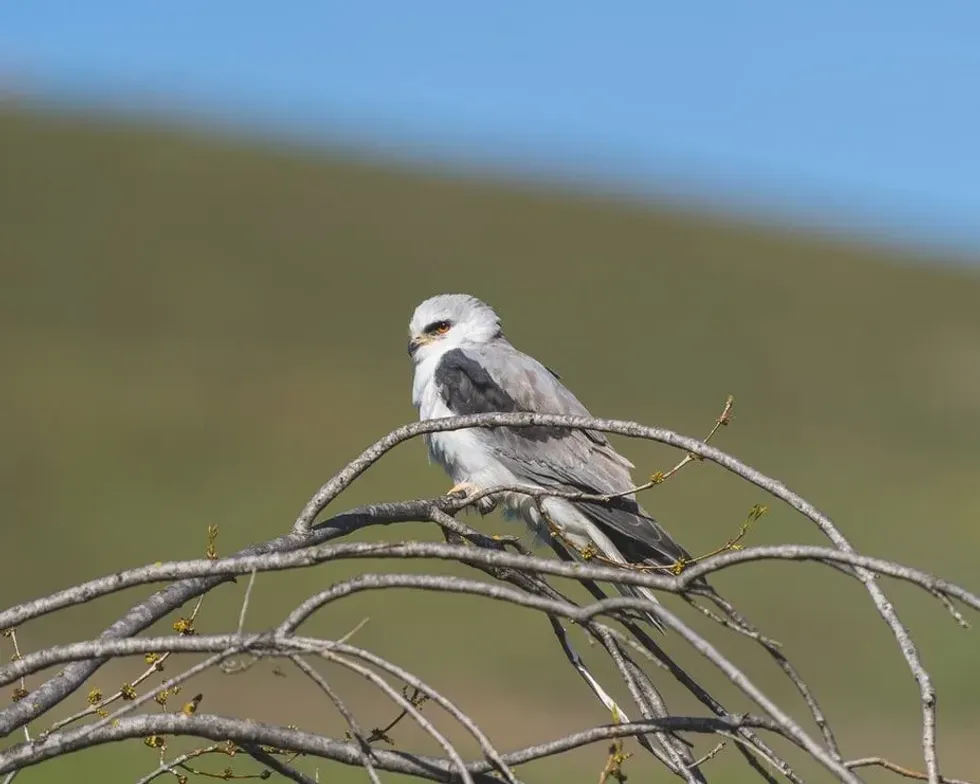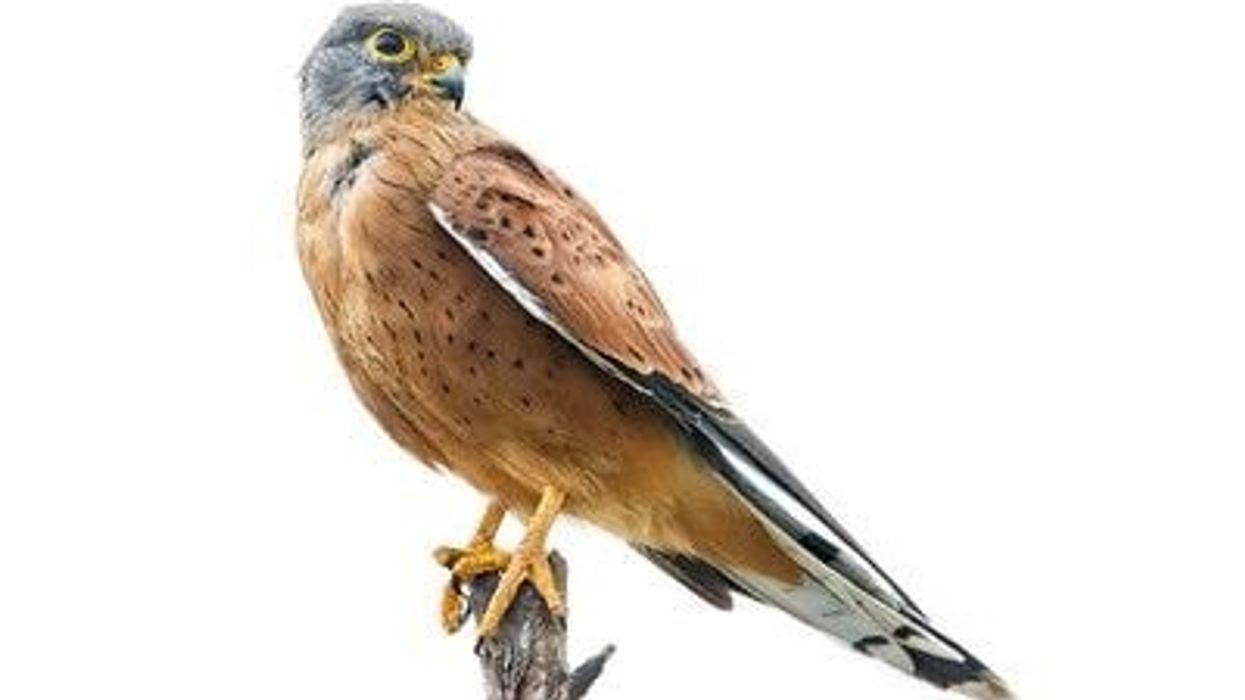The white-tailed kite is a feisty and ferocious kind of bird to learn about. They belong to the family Accipitridae.
They are members of preying birds, also known as birds of prey, such as vultures, bald eagles, and hawks. The members of this bird family can be spotted in areas or habitats like river valleys, farm country, savannas, fields, lowland scrub, grasslands, and more. This habitat can be found in the United States, among other places.
The food source of these members of the Accipitridae family is mainly dependent on rodents. These birds have long wings, with a wingspan of 40 in (102 cm). Additionally, the tip of these wings is black in color.
Their shoulders are also covered in black plumage, whereas, the rest of the body is covered in white or greyish feathers. The most unique physical feature of these birds is their red eyes.
Keep on reading to know more about their features and other interesting facts. If you liked this article, check out blue jay facts and little bee-eater facts.
White-Tailed Kite Interesting Facts
What type of animal is a White-Tailed Kite?
The white-tailed kite (Elanus leucurus) is a type of bird.
What class of animal does a White-Tailed Kite belong to?
The white-tailed kite (Elanus leucurus) belongs to the class Aves.
How many White-Tailed Kites are there in the world?
There are a number of varied data regarding the population of the white-tailed kite. The International Union for Conservation of Nature (IUCN) Red List states that approximately 500,000-5 million birds of this species roam the surface of the Earth at present.
On the other hand, All About Birds believes the number of white-tailed kites to stand at 2 million. Overall, it can be said that they have a hefty population. Moreover, their numbers are said to be on the rise.
Where does a White-Tailed Kite live?
The white-tailed kite, belonging to the Accipitridae family, is native to North America as well as South America. Within the range of California, they can be spotted in Central Valley, Goleta, and San Francisco Bay.
Apart from California, other North American places that host these birds include southern parts of Texas and eastern Mexico. They inhabit the Baja California Peninsula as well.
Their geographic range moves along Central America to South America where they can be spotted in Chile and Argentina. Studies also show that in 2010, two white-tailed kites were spotted as far north as New England.
What is a White-Tailed Kite's habitat?
The white-tailed kite from the family Accipitridae requires trees to rest on, and also to build nests in. Apart from that, these birds prefer a habitat with open fields.
The field areas should have an abundance of rodents that are easily visible. The white-tailed kite primarily inhabits areas such as valleys situated by the banks of streams or rivers, and grasslands or savanna.
These birds can also be spotted in marshes and open groves. In North America, they can reside in areas in deserts that are covered with grasslands, marshes, oak lands, and farms by the countryside.
Who do White-Tailed Kites live with?
White-tailed kites are known for their social behavior. They can be seen gathering in groups, which can consist of as many as 100 individuals. They form this gathering mostly during resting or sleeping. On the other hand, during the breeding season, the white-tailed kites form a pair with one member of the opposite gender.
How long does a White-Tailed Kite live?
On average, the white-tailed kite lives for around five years. The longest recorded lifespan of a white-tailed kite is six years.
How do they reproduce?
White-tailed kites are monogamous in nature. They form pairs that last throughout one whole breeding season.
The male white-tailed kite performs a number of courtship acts. One of them is when the male offers prey to the female.
On such an occasion, the female can at times be seen flying up in the air to meet the male. The female then turns her body upside down and then catches the prey dropped by the male. Another display of courtship on part of the male includes him flying with his wings in a sharp 'V' shape.
After forming a pair, the male and female choose a nest site on trees, to build their nest. Following this, the female white-tailed kite lays between three and six eggs.
She only broods once per breeding season. The eggs that are laid are white with brown spots and are incubated for 30-32 days before they hatch.
What is their conservation status?
As per the International Union for Conservation of Nature (IUCN) Red List, these birds are a species of Least Concern. This means that there is no threat of their endangerment or extinction in the foreseeable future. In fact, their numbers are increasing by the day.
White-Tailed Kite Fun Facts
What do White-Tailed Kites look like?

The white-tailed kite is shaped like a falcon. It has a rounded tail and pointy wings. The underpart of their plumage is mostly covered with white feathers. The tips of the wings and shoulders are black in color. Another distinct feature of this species is their red eyes.
How cute are they?
This species of kites are not exactly cute, instead, they have a ferocious and majestic appearance.
How do they communicate?
Touch, sight, and sound are the modes of communication used by the white-tailed kite. White-tailed kites can also perceive through chemical signals. Little is known about the calls of the white-tailed kite. They are, however, known to give out screeches, cries, and whistles. These vocalizations can be seen in the birds during hunting, courtship, and mating.
How big is a White-Tailed Kite?
The birds of this species measure about 12.6-15 in (32-38 cm) in length. White-tailed kites are more than double the size of a house sparrow.
How fast can a White-Tailed Kite fly?
The speed of flight remains unknown for the white-tailed kite. They are, however, known to be fast fliers.
How much does a White-Tailed Kite weigh?
On average, these birds weigh approximately 10.6-12.7 oz (300-360 g).
What are the male and female names of the species?
The male is called a cock, while the female is called a hen.
What would you call a baby White-Tailed Kite?
Baby or young birds are called chicks.
What do they eat?
The primary prey of these birds is rodents, house mice, voles, rats, and harvest mice can fall prey to the white-tailed kite. White-tailed kites prefer small rodents that are out in the open field during the daytime.
Other prey for this species, include young rabbits, pocket gophers, and occasionally other birds, as well. These North American birds can also be seen feasting on snakes, frogs, lizards, and big insects on occasion.
Are they poisonous?
To date, there have been no records of this species of bird being poisonous.
Would they make a good pet?
It is not likely for this bird species to make a good pet. They are ferocious by nature and need live rodents for food. Hence, it is difficult to take care of them and to provide appropriate maintenance for this species.
Did you know...
By behavior, the white-tailed kite is territorial. This might lead to aerial fights between males where they lock talons. This action is called 'grappling'.
The adult white-tailed kite has red eyes. These red eyes help to maintain the opacity of their eyes, and thus, in turn, regulates the amount of light that enters into their eyes.
The white-tailed kite can be distinguished from other kites primarily by its appearance. White-tailed kites have red eyes and a long white tail that is rounded. They can also be identified by their diet since they can only be seen hovering over rodents and never over the water since they do not eat fish.
Do White-Tailed Kites migrate?
No, these North American birds do not migrate. They wander away from their geographic range (such as California, Texas, South America) only in search of food.
Do White-Tailed Kites mate for life?
No, these birds, who are native to California, do not mate for life. They form monogamous pair bonds for one year. Their mating behavior is serially monogamous. This means that they mate only for one mating season and the mate may change for the next season.
Here at Kidadl, we have carefully created lots of interesting family-friendly animal facts for everyone to discover! Learn more about some other birds including red kite facts and bee hummingbird facts.
You can even occupy yourself at home by coloring in one of our free printable white tailed kite coloring pages.










